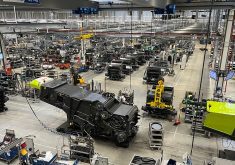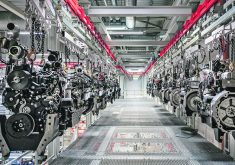Demand is high for new equipment. But supply chain issues, interest rates, COVID and the Russian war have combined to throw a monkey wrench into farmer’s equipment purchase plans.
The financial situation has improved for many farms that have been holding onto machines longer than they typically do, but there are now long waiting lists for farm equipment.
Availability of components has improved slightly since last year. Prairie agricultural implement firms have come to grips with the new reality that it’s a seller’s market when it comes to components.
Read Also

Manitoba Parkland research station grapples with dry year
Drought conditions in northwestern Manitoba have forced researchers at the Parkland Crop Diversification Foundation to terminate some projects and reseed others.
With delivery dates a full year out for wheels and tires, and delivery 16 months out for hydraulic motors, supply chain issues can cause major problems when sourcing components at Morris Industries. Their wait times are similar to other prairie manufacturers.
Just emerging from bankruptcy put an extra strain on component procurement for Morris Industries, according to sales and marketing manager Garth Massie.
“It did put us behind the eight ball in comparison to other years. But it was a difficult year no matter how you look at it,” said Massie, adding that demand for machinery is high. Meeting that demand on time has been a real challenge.
“We intentionally had a more limited sales program. And we’re opening sale programs much earlier than normal so we can place our orders from suppliers. The situation forces manufacturers to do more forecasting, and you need confirmed sales to ensure your forecasting is accurate.
“These longer lead times really make it difficult to set prices. When we sell a drill for next spring, we guarantee that price to the farmer. If our supplier has to raise (prices), we pay, we do not pass that increase on to the farmer. Some companies are adding a steel surcharge to cover rising steel costs. Morris doesn’t do that. We absorb the extra cost. We feel it’s not fair to the farmer to pass those cost bumps on to him.”
Another aspect of the scene is the inability to change the original order. In normal circumstances, a manufacturers component inventory was full enough that a farmer could make changes to the specs. Massie says that’s no longer the case.
He says steel availability now is fairly good. Steel was tight enough last year that Morris had to drop certain models from the catalogue. However, at no point were they forced to cancel an order or delay delivery.
Association of Equipment Manufacturers spokesperson Curt Blades dispelled rumours that the big implement companies jump the component cue, thus leaving small Canadian manufacturers empty-handed. He told The Western Producer that it’s strictly first come, first served.
“It all depends on the date on the contract. Bigger companies plan further out, so that can give them an advantage on delivery times. But they’re behind on production just like the smaller companies.
“All it takes is one component to be missing and your whole tractor or drill ends up sitting in the compound, waiting. There’s no point in delivering a combine that doesn’t have an auger. If you’re missing one piece, you don’t have a machine. But you have tied up your money and you’ve tied up all the other components as well.
“The whole global supply chain is highly connected. You might require a hydraulic fitting from Europe or glass or wiring harnesses from the other side of the world. You can’t gear up overnight in North America to build those offshore components we depend on.”
Factories want their component suppliers as close as possible, but globalization has moved those sources halfway around the earth in many cases. The supply chain can only stretch so far before it breaks.
Just-in-time management means the factory doesn’t stock a big inventory. For just-in-time inventory and shipping systems to work, every little movement must flow seamlessly. Rather than creating financial efficiency, just-in-time inventory control has created a huge backlog of machines that are almost finished.
“Just-in-time is incredibly efficient, but we learned during the pandemic that it’s also incredibly fragile. Industry is re-thinking their commitment to just-in-time. Leaders are thinking they may want to move their suppliers just a little closer and more diversified.
“Couple that factor with global unrest, and we see a future that’s very hard to predict.”
Bri-Steel in Edmonton is headed by Neil Rasmussen. Bri specializes in seamless thermal pipe expansion for industrial purposes. As such, the company is not a major buyer of steel compared to firms that build ag implements.
Rasmussen said Bri buys 15,000 tonnes per year.
“As a small player, we haven’t had a problem yet buying raw materials. For a while, there had been some glitches in getting deliveries on time from China, but that was minor,” said Rasmussen, adding that Bri is North America’s only producer of seamless pipe up to 36 inches in diameter.
“There have been a lot of business closures in recent years because of COVID. Some of our competitors have disappeared, so our production has grown to fill that demand. We’re now looking at north-south expansion.”
Rasmussen says about 80 percent of their pipe is sold to the United State with the balance going to Canadian buyers. One of the reasons they have not experienced a shortage of steel is their carefully planned purchase strategy. If the mill has to shut down for even a day, it takes three or four days to bring it up to full production again. That’s a major expense.
Deliveries are so tightly scheduled that Bri accounts for time lost during Chinese New Year at the shipper’s end. Supply chain issues in 2020 were so severe there were often 40 ships tied up in Port of Vancouver and another 40 ships waiting to get into the docks.
“The energy issue in Europe is forcing mills to shut down, and that has a huge ripple effect throughout industry. I think European industry is being sacrificed by this protest. Valtimet, one of the leading firms, has shut down 15 steel mills already.
“It’s not only the energy issue. Potential customers are hesitant to order steel and manufactured products from Europe because of the un-certainty and the war. I think much of the European steel industry will move to Asia. They don’t have the supply issues or the energy issues we have in the west.
“Even if war ended today, Europe will be in trouble for many years. They’re in deep. People are going to starve and freeze this winter. It’s going to be ugly. It’s the lower end of the population that will pay the price.”


















